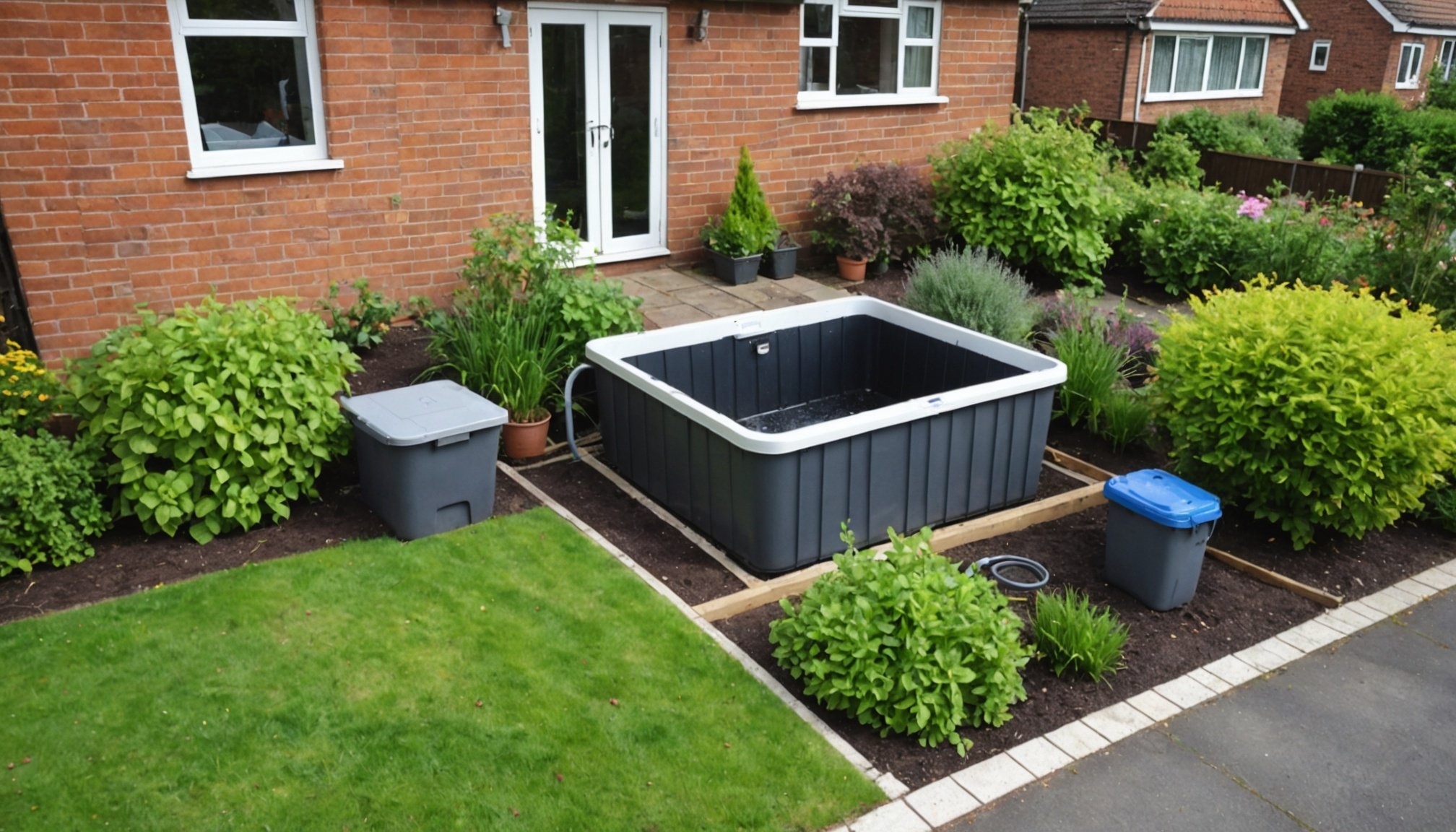Are you ready to enhance your home's sustainability? Installing a greywater recycling system can drastically reduce water waste while contributing to a greener environment. This comprehensive guide simplifies the process, from initial considerations to installation steps. Embrace the benefits of conserving precious resources and reducing utility bills. Discover how you can transform your suburban UK home into an eco-friendly haven while appealing to your modern lifestyle.
Understanding Greywater Recycling Systems
Greywater recycling is an innovative approach to water conservation, offering significant environmental benefits. By reusing water from sinks, showers, and washing machines, these systems reduce the demand on freshwater resources and lower the volume of wastewater entering sewage systems. This process is pivotal in promoting sustainability.
A voir aussi : Transforming Your Derby Home: A Guide to Retrofitting Old Electrical Systems for Smart Home Integration
Unlike traditional water usage, which often results in a one-time use followed by disposal, greywater recycling allows for multiple uses of the same water. This not only conserves water but also reduces the energy and resources required for water treatment. By implementing greywater systems, households and businesses can significantly decrease their water footprint.
The environmental benefits of greywater recycling are substantial. It aids in the reduction of water extraction from natural sources, preserving aquatic ecosystems. Additionally, it diminishes the load on sewage treatment facilities, leading to reduced greenhouse gas emissions associated with water processing.
A lire également : Transform Your UK Home: Embrace Sustainable and Eco-Friendly Decor Solutions!
In comparison, traditional water usage systems are less efficient and often contribute to water scarcity issues. By adopting greywater recycling, individuals and communities can contribute to a more sustainable future, ensuring that water resources are available for generations to come. This method not only supports water conservation but also aligns with broader environmental goals, making it a crucial component of modern sustainability strategies.
Materials Needed for Installation
Installing a greywater recycling system requires a comprehensive set of materials and tools to ensure efficiency and functionality. At the core of the installation are the greywater system components, which include pipes, tanks, and filters. These are essential for directing, storing, and purifying the recycled water.
When embarking on a DIY project, sourcing the right installation materials is crucial. Common DIY supplies include PVC pipes, which are favoured for their durability and ease of installation. Additionally, pumps are necessary for moving water through the system, and they come in various models suited for different capacities.
For UK residents, sourcing materials can be streamlined by choosing recommended brands known for quality and reliability. Brands like Polypipe and Wavin offer robust piping solutions, while Grundfos provides efficient pump options. These brands are widely available through local hardware stores and online retailers, making them accessible for DIY enthusiasts.
Essential tools for installation include pipe cutters, wrenches, and sealants, ensuring that all connections are secure and leak-free. By carefully selecting the right materials and tools, individuals can create a functional greywater recycling system tailored to their specific needs, promoting both water conservation and environmental sustainability.
Step-by-Step Installation Process
Embarking on a DIY installation of a greywater recycling system involves careful planning and execution. Begin with a pre-installation site assessment to evaluate the plumbing layout and potential locations for the system components. This step ensures that the greywater system setup is both efficient and effective.
Pre-Installation Planning
- Assess Plumbing Layout: Identify existing water sources that can supply greywater, such as sinks and showers.
- Select Component Locations: Determine where to place tanks, filters, and pumps for optimal flow and access.
- Check Local Regulations: Ensure compliance with local building codes and environmental regulations.
Detailed Installation Steps
- Prepare Materials: Gather all necessary parts, including pipes, tanks, and pumps.
- Install Piping: Connect PVC pipes from greywater sources to the storage tank, ensuring a secure fit.
- Set Up Filtration: Attach filters to remove impurities, protecting the system from clogs.
- Position the Pump: Install the pump to facilitate water movement through the system.
Common Challenges and Troubleshooting
- Leaks: Use sealants to address any leaks in connections.
- Clogs: Regularly clean filters to maintain water flow.
- Pump Malfunctions: Ensure the pump is compatible with the system capacity to avoid breakdowns.
Legal Considerations in the UK
Navigating the legal requirements for greywater systems in the UK is essential for compliance and successful implementation. The UK has specific regulations to ensure that greywater recycling is conducted safely and effectively.
Overview of UK Regulations
In the UK, greywater systems must adhere to both national and local regulations. These rules are designed to protect public health and the environment. Key regulations include compliance with the Building Regulations and Water Supply (Water Fittings) Regulations. These ensure that installations do not compromise water quality or safety.
Necessary Permits and Documentation
Before installing a greywater system, obtaining the necessary permits is crucial. This might involve submitting plans to local authorities for approval. Documentation should demonstrate that the system meets all legal requirements and health standards. Consulting with professionals can aid in navigating this process.
Compliance with Health and Safety Standards
Health and safety standards are paramount when implementing greywater systems. Ensuring that all components are installed correctly and maintained regularly is vital to prevent contamination. Systems must be designed to avoid cross-connection with potable water supplies, safeguarding public health. Regular inspections and maintenance are recommended to ensure ongoing compliance.
Cost Estimates and Budgeting
Implementing a greywater system involves a thorough cost analysis to ensure effective budgeting. Understanding the potential expenses is crucial for planning and financial management.
Breakdown of Potential Costs
- Materials: The primary expenses include pipes, tanks, and pumps. Quality components, such as those from reputable brands, can range from £500 to £2,000.
- Labour: Professional installation services may cost between £1,000 and £3,000, depending on the complexity and scale of the project.
- Permits: Acquiring necessary permits and meeting regulatory requirements can add an additional £100 to £500.
Average Cost Estimates for Suburban UK Homes
For a typical suburban home in the UK, the total cost of installing a greywater system might range from £2,000 to £6,000. This estimate includes all materials, labour, and permits, providing a comprehensive view of potential financial commitments.
Tips for Budgeting and Financial Planning
- Set a Budget: Determine your maximum spend and allocate funds accordingly.
- Research and Compare: Obtain multiple quotes from suppliers and installers to find competitive prices.
- Plan for Maintenance: Include ongoing maintenance costs in your budget to ensure the system remains efficient and compliant.
Maintenance Tips for Longevity
Proper system maintenance is crucial for the efficient operation and longevity of a greywater recycling system. Regular upkeep ensures that the system functions correctly and prevents costly repairs.
Regular Maintenance Tasks and Schedules
- Filter Cleaning: Clean filters monthly to prevent clogs and ensure smooth water flow.
- Pipe Inspection: Check pipes for leaks or blockages every three months.
- Pump Testing: Test the pump bi-annually to confirm it is operating efficiently.
Signs of Potential Issues and How to Address Them
Identifying early signs of problems can save time and money. Look for unusual noises from the pump or reduced water flow, which may indicate a blockage or mechanical issue. Address leaks promptly to avoid water damage and inefficiencies. Employ sealants or replace faulty components as needed.
Resources for Maintenance Support and Troubleshooting
Utilise manufacturer manuals for detailed maintenance instructions specific to your system. Online forums and community groups can provide valuable insights and troubleshooting tips. For complex issues, consulting with a professional experienced in greywater management can ensure proper repairs and system optimisation. Regular maintenance and proactive problem-solving are key to sustaining an effective greywater system.
Environmental and Financial Benefits
Implementing a greywater recycling system offers significant savings on water bills. By reusing water from daily activities, households can reduce their dependency on municipal water supplies, leading to lower monthly expenses. Over time, these savings can offset the initial installation costs, making it a financially viable option for many.
Beyond financial gains, the environmental impact of greywater recycling is profound. By decreasing the demand for freshwater extraction, these systems help preserve natural water bodies and ecosystems. Additionally, they contribute to reducing the burden on sewage treatment facilities, which in turn lowers greenhouse gas emissions associated with water processing.
Positive Environmental Impacts
- Reduced Water Consumption: Greywater systems enable multiple uses of the same water, conserving precious resources.
- Ecosystem Preservation: By lessening the need for freshwater extraction, natural habitats remain undisturbed.
Case Studies
Numerous case studies underscore the success of greywater systems in promoting sustainable living. For instance, a community in Bristol reported a 30% reduction in water usage after adopting greywater recycling. Such examples highlight the dual benefits of cost savings and environmental preservation, encouraging wider adoption of this sustainable practice.
Best Practices for Greywater Use
Understanding best practices for greywater use is essential for maximising its benefits and ensuring sustainable practices. Proper greywater usage tips can enhance both environmental and financial outcomes.
Recommended Practices for Using Greywater
-
Proper Filtration: Ensuring greywater is adequately filtered before use is crucial. This prevents contaminants from affecting soil and plants, maintaining a healthy ecosystem. Implementing robust filtration systems can reduce the risk of blockages and prolong the lifespan of your system.
-
Sustainable Practices: Utilising greywater for irrigation is a sustainable practice that conserves freshwater. It is recommended to use greywater on non-edible plants and avoid direct contact with foliage to minimise health risks.
Plants and Landscaping that Benefit from Greywater
Certain plants thrive with greywater irrigation. Drought-resistant and hardy species, such as lavender and rosemary, are excellent choices. These plants can tolerate the varying nutrient levels in greywater, making them ideal for eco-friendly landscaping.
Importance of Proper Filtration and Treatment
Proper treatment of greywater is vital to prevent soil degradation and protect plant health. Regular maintenance of filters and treatment systems ensures that greywater remains a safe and effective resource for irrigation. By following these best practices, greywater can be a valuable asset in sustainable living.
Homeowner Testimonials and Case Studies
Exploring success stories of greywater systems offers valuable insights into their real-world applications. Homeowners who have embraced these systems often share transformative experiences, highlighting both challenges and triumphs.
In interviews, many homeowners recount initial concerns about installation and maintenance. However, these were often mitigated through careful planning and professional guidance. For instance, a homeowner in Manchester faced difficulties with system integration into an older plumbing setup. By consulting with experts and utilising adaptable components, they successfully overcame these hurdles.
The impact of greywater systems on daily life is profound. Homeowners report noticeable reductions in water bills and a heightened awareness of water usage. One family in London expressed satisfaction with their system's contribution to sustainable living, noting a 25% decrease in water consumption. Such experiences underscore the practical benefits and environmental contributions of greywater systems.
Overall, these testimonials reflect a high degree of satisfaction. Homeowners appreciate the dual advantages of cost savings and environmental stewardship. By sharing their stories, these individuals inspire others to consider greywater systems as a viable solution for sustainable home management, fostering a community of environmentally conscious homeowners.











